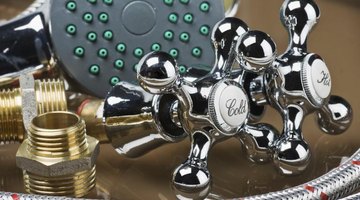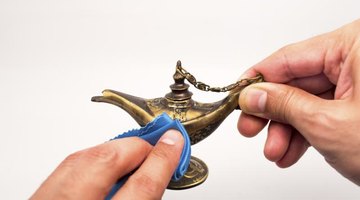How to Tell the Difference Between Stainless Steel and Brass
Stainless steel and brass are metallic alloys utilized in lighting fixtures, door hardware, picture frames, candlesticks and other decorative items. Metal formulators have produced decorative brass statuary dating to ancient times, using a recipe composed primarily of copper and zinc. There are many ways to manufacture decorative items from stainless steel, but in all varieties, the primary ingredients are iron and chrome. Because modern home designers utilize brass for many of the same purposes as stainless steel, it's useful to distinguish the two so you can properly clean and maintain them.
Recognizing Brass


Brass items are available in a rich variety of coloration, which ranges from dark yellow to reddish-gold. Thin brass items such as cymbals or vases feature acoustic properties and produce a resonant ringing tone when impacted by a drumstick or mallet. Decorative brass is often coated with a lacquer that protects the outer surface from shifting colors due to oxidation. Oxidation creates a patina that adds a dark gray or greenish cast to brass that is often preferred by home decorators.
Recognizing Stainless Steel

Unlike brass, stainless steel has a silvery white appearance often polished to a brilliant shine. Despite the name, decorative stainless steel items can discolor because of corrosion or simple rust -- usually the result of a flaw in the manufacturing process. That discoloration may give the stainless steel an appearance similar to brass. A simple way to confirm that a metal is stainless steel is to press a magnet against its surface; unlike brass, most varieties of stainless steel are highly magnetic.
Cleaning Decorative Brass and Stainless Steel

Once you've determined whether an object is brass or stainless steel, you can select the best method for cleaning and maintaining it. You can find products designed for the specific cleaning needs of brass and stainless steel at hardware stores and most larger grocery stores. Most brass can be cleaned using a few drops of ketchup on a damp kitchen rag, and you can usually return the shine to stainless steel by wiping it with a rag soaked in diluted dish detergent.
References
Resources
Writer Bio
Mike Matthews is editor of Green Building Product News, a national publication that covers sustainable innovations in building and remodeling, and he has spoken at national conferences on green building. He has also served as founding editor of "Paint Dealer" magazine.
Photo Credits
- DoroO/iStock/Getty Images
- pkazmercyk/iStock/Getty Images
- Dmitry Naumov/iStock/Getty Images
- Manuel-F-O/iStock/Getty Images
More Articles



